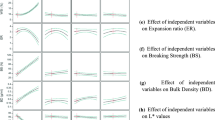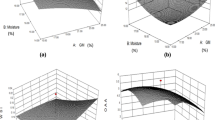Abstract
Indian traditional staple and snack food is typically a heterogeneous recipe that incorporates varieties of vegetables, lentils and other ingredients. Modelling the retorting process of multilayer pouch packed Indian food was achieved using lumped-parameter approach. A unified model is proposed to estimate cold point temperature. Initial process conditions, retort temperature and % solid content were the significantly affecting independent variables. A model was developed using combination of vegetable solids and water, which was then validated using four traditional Indian vegetarian products: Pulav (steamed rice with vegetables), Sambar (south Indian style curry containing mixed vegetables and lentils), Gajar Halawa (carrot based sweet product) and Upama (wheat based snack product). The predicted and experimental values of temperature profile matched with ±10 % error which is a good match considering the food was a multi component system. Thus the model will be useful as a tool to reduce number of trials required to optimize retorting of various Indian traditional vegetarian foods.






Similar content being viewed by others
Abbreviations
- F:
-
Accumulated lethality (min)
- fh :
-
Heating rate constant
- jc :
-
Lag constant
- kc :
-
Empirical model constant for cooling
- kh :
-
Empirical model constant for heating
- L:
-
Lethality
- t:
-
Time (min)
- R2 :
-
Correlation regression coefficient
- RMSE:
-
Root mean square error
- SS:
-
Sum of squares of errors
- Ta :
-
Ambient temperature (°C)
- Tcw :
-
Cooling water temperature (°C)
- TP :
-
Product temperature (°C) at any time t
- TP0 :
-
Initial product temperature (°C)
- TR :
-
Desired retort temperature (°C)
- Tref :
-
Reference temperature (°C)
- z:
-
Slope index of thermal death curve (°C)
- χ 2 :
-
Chi square error
References
Abbatemarco C, Ramaswamy HS (1994) End-over-end thermal processing of canned vegetables: effect on texture and color. Food Res Int 27(4):327–334
Alonso AA, Banga JR, Perez-Martin R (1997) A complete dynamic model for the thermal processing of bioproducts in batch units and its application to controller design. Chem Eng Sci 52(8):1307–1322
Baucour P, Cronin K, Stynes M (2003) Process optimization strategies to diminish variability in the quality of discrete packaged foods during thermal processing. J Food Eng 60(2):147–155
Bindu J, Ravishankar CN, Srinivasa Gopal TK (2007) Shelf life evaluation of a ready-to-eat black clam (Villorita cyprinoides) product in indigenous retort pouches. J Food Eng 78(3):995–1000
Box GEP, Behnken DW (1960) Some new three level designs for the study of quantitative variables. Technometrics 2:455–475
Chandrasekar V, Srinivasa Gopal TK (2008) Heat penetration characteristics of mushroom curry packed in retort pouch. Int J Postharvest Technol Innov 1(3):312–319
Chandrasekar V, Gopal TKS, Rai RD (2004) Heat penetration characteristics and shelf-life studies of mushrooms in brine processed in retort pouches. Packag Technol Sci 17(4):213–217
Chen CR, Ramaswamy HS (2002a) Modeling and optimization of constant retort temperature (CRT) thermal processing using coupled neural networks and genetic algorithms. J Food Process Eng 25(5):351–379
Chen CR, Ramaswamy HS (2002b) Modeling and optimization of variable retort temperature (VRT) thermal processing using coupled neural networks and genetic algorithms. J Food Eng 53(3):209–220
Chen CR, Ramaswamy HS (2003) Analysis of critical control points in deviant thermal processes using artificial neural networks. J Food Eng 57(3):225–235
Chen CR, Ramaswamy HS (2007) Visual Basics computer simulation package for thermal process calculations. Chem Eng Process 46(7):603–613
Dileep AO, Sudhakara NS (2007) Retortable pouch packaging of deep-sea shrimp (Aristeus alcocki) in curry and quality evaluation during storage. J Food Sci Technol 44(1):90–93
Geetha P, Jayaraj Rao K (2008) Technology of retort processed poppy seeds (Papaver somniferum) payasam. 2. Shelf-life studies. J Food Sci Technol 45(6):534–536
Gonçalves EC, Minim LA, Coimbra JSR, Minim VPR (2005) Modeling sterilization process of canned foods using artificial neural networks. Chem Eng Process 44(12):1269–1276
Jayakumar V, Pandey MC, Jayathilakan K, Manral M (2007) Development and evaluation of thermally processed pearlspot (Etroplus suratensis) fish curry. J Food Sci Technol 44(4):350–352
Mallick AK, Srinivasa Gopal TK, Ravishankar CN, Vijayan PK (2006) Canning of rohu (Labeo rohita) in North Indian style curry medium using polyester-coated tin free steel cans. Food Sci Technol Int 12(6):539–545
Miri T, Tsoukalas A, Bakalis S, Pistikopoulos EN, Rustem B, Fryer PJ (2008) Global optimization of process conditions in batch thermal sterilization of food. J Food Eng 87(4):485–494
Montgomery DC (1984) Design and analysis of experiments. Wiley, New York
Paul Singh R, Heldman DR (2004) Introduction to food engineering. Academic, New Delhi
Prakash M, Ravi R, Sathish HS, Shyamala JC, Shwetha MA, Rangarao GCP (2005) Sensory and instrumental texture measurement of thermally processed rice. J Sens Stud 20(5):410–420
Ravi Shankar CN, Srinivasa Gopal TK, Vijayan PK (2002) Studies on heat processing and storage of seer fish curry in retort pouches. Packag Technol Sci 15(1):3–7
Rodríguez JJ, Olivas GI, Sepúlveda DR, Warner H, Clark S, Barbosa-Cánovas GV (2003) Shelf-life study of retort pouch black bean and rice burrito combat rations packaged at selected residual gas levels. J Food Qual 26(5):409–424
Sablani SS, Shayya WH (2001) Computerization of Stumbo’s method of thermal process calculations using neural networks. J Food Eng 47(3):233–240
Simpson R, Almonacid S, Mitchell M (2004) Mathematical model development, experimental validation and process optimization: retortable pouches packed with seafood in cone frustum shape. J Food Eng 63(2):153–162
Acknowledgment
The authors would like to acknowledge the “University Grant Commission (UGC)”, Government of India for financial support.
Author information
Authors and Affiliations
Corresponding author
Rights and permissions
About this article
Cite this article
Gokhale, S.V., Lele, S.S. Retort process modelling for Indian traditional foods. J Food Sci Technol 51, 3134–3143 (2014). https://doi.org/10.1007/s13197-012-0844-3
Revised:
Accepted:
Published:
Issue Date:
DOI: https://doi.org/10.1007/s13197-012-0844-3




